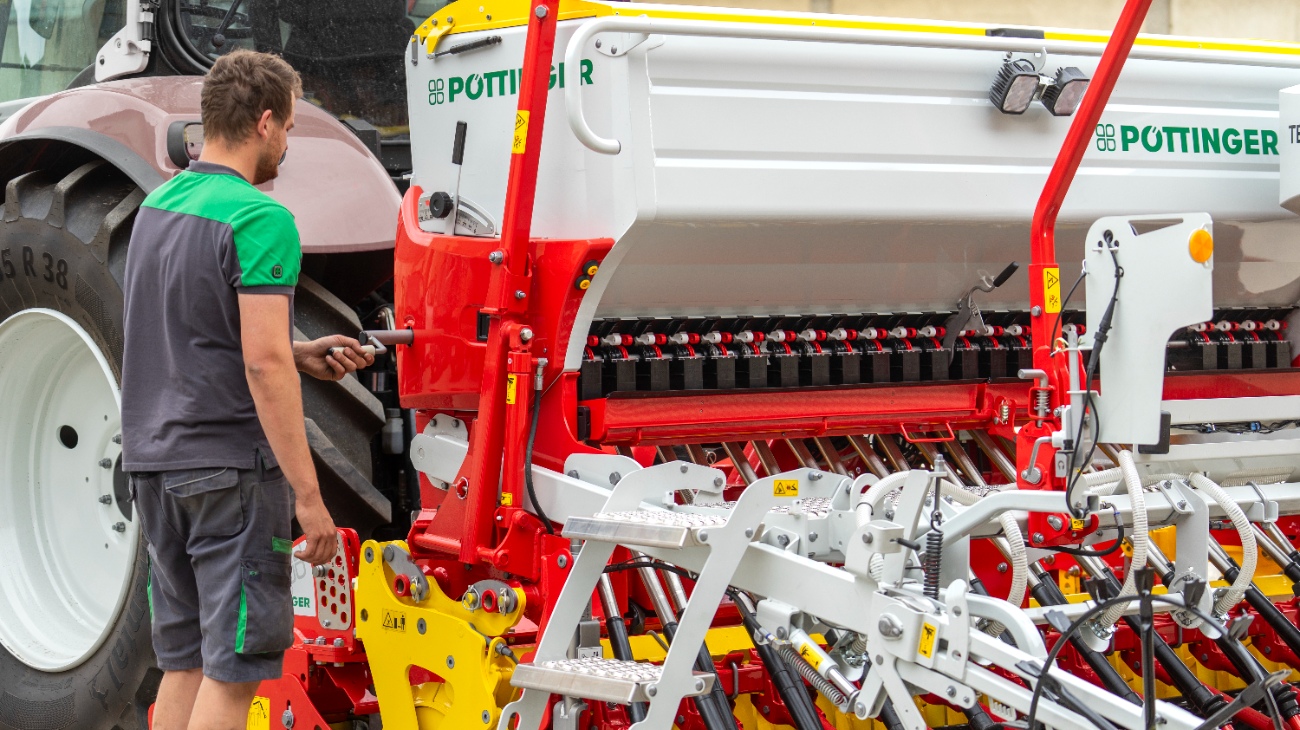The potential of direct fertilization seed drills
Mulch drilling example with summer durum wheat
At the University of Natural Resources and Life Sciences in Vienna, department for agricultural plants, a test was performed in 2012 as part of a thesis project using the Pöttinger TERRASEM C6 fertilizer seed drill with direct fertilizer application system.
The test performed for the thesis analysed the following questions:
- Does direct fertilization produce higher yields with summer grain crops?
- Which fertilizer achieves the highest growth in yield with direct fertilization?
- Which size of fertilizer deposit (during drilling) achieves the highest yield with direct fertilization?
The test conditions:
It was extremely dry (155 mm) in 2012 during the growing season. The first usable precipitation fell in June. It was also very cold up until the end of March. The winter catch crop was white radish, after which there was no primary tillage.
At the time of direct mulch drilling on 5 March 2012 the ground was extremely dry (low winter moisture), with around one third of the usual precipitation. It was observed that crop growth was delayed due to the dry conditions. Harvesting took place on 17 July 2012.

Three fertilizer regimes, each with 120 kg nitrogen:

NS = Post-drill
UFD = Direct fertilization
Technical settings:
- Summer durum: 430 grains/m2 (TKG 47)
- Drill depth 3 cm
- Direct fertilization - alternative to post-drill application (basis)
- Three types (NAC 27%N, urea 46%N, ENTEC 26%N)
- Fertilizer placement depth 8 cm
- Yield report at 14 %


In the face of increasing fertilizer prices, new types of fertilizer, new fertilizer regulations and environmental legislation, it pays to employ precision fertilizer management in future. With two methods of applying direct fertilization, Pöttinger TERRASEM mulch seed drills offer the right process for a wide range of individual needs and operating conditions.
Very low precipitation of 62 litres during main growth:

Yield evaluation:

NS = Post drilling: fertilizer applied after drilling (= basis 100 %)
UFD = Direct fertilization
120 kg RN was applied to all plots in summer!
Interpretation of test results with TERRASEM C6 fertilizer:
- Above 120 kg NAC direct fertilization achieves approx. 8 % higher yield
-» Extra yield due to low emission losses -» Good supply (over-supply) to the plants
- 40 kg urea direct fertilization and the rest applied conventionally achieves a higher yield of up to 4.5 %
-» Higher yield due to low emission losses for the first 40 kg applied direct and slow plant availability in-line with rate of growth
-» Urea applied post drilling (2 x 40 kg) has high rate of atmospheric loss (20 – 35 % is lost)
- 120 kg ENTEC applied direct achieves the highest increase in yield + 18%
-» Consistent, slow mineralisation of the fertilizer – continuous supply to the plants
during the whole phase
-» No losses due to evaporation
With direct fertilization up to 20 % higher yield is possible with 120 kg pure nitrogen. Higher yield is possible thanks to consistent supply and mineralisation.
The advantages of direct fertilization:
- Depending on soil warmth and availability of water, the application time of the fertilizer is virtually identical to plant development
- No losses due to washing out or emission into the air
- • 50 % can be applied during drilling and 50 % applied before the generative growth phase (EC 36). The advantage is that the fertilizer amount can be varied depending on the growth of the crop.
The following results were achieved in terms of young plant development: - Fertilizer applied to the upper soil area promotes young plant growth and faster ground coverage - higher biomass growth
- It has been noted that nitrate heavy fertilizers tend to have a negative effect on young plant development in dry conditions
- The plants take up the nutrients very slowly if conditions remain dry
- Drying out occurs faster than the roots are able to develop into the soil
- Slow-flowing fertilizer has a slight toxicity effect in dry growth conditions
The results on late development:
- Due to lack of moisture, the fertilizer did not have full effect (shown by Nmin tests) -> fertilizer was not mineralized!
- Slow flowing fertilizers favour higher fertilizer amounts for direct fertilization (risk of acidity)
- Fertilizer amounts above 110 kg N do not produce significant additional yield
- Too much fertilizer can result in a reduction in yield
- Risk that N concentration is too high close to roots, causing acidity (120 kg urea-ammonium), especially in dry conditions
Summary:
Based on the weather and extreme dryness during the observation period, an increase in yield is possible due to water-saving drilling and fertilization. For increased amounts of fertilizer, crop yield increases with direct fertilization. The exception here is urea, where the risk of toxicity at root level increases with each additional amount.
If it rains immediately after drilling with direct fertilization, the fertilizer will dissolve into the ground faster. This means that the concentration around the roots is reduced, along with the risk of toxicity. Spring drilling with direct fertilization results in lower losses into the atmosphere so that the nutrients are available to the plants. Changes in the climate will continue to change fertilizer application in farming in future. Pöttinger TERRASEM mulch seed drills with direct fertilizer application offer the right process for a wide range of individual needs and operating conditions.



